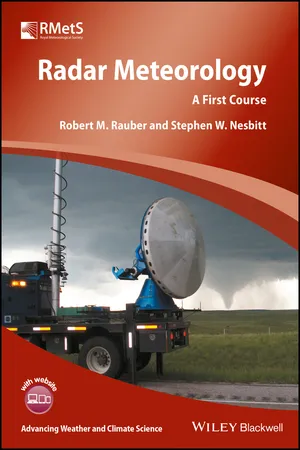
- English
- ePUB (mobile friendly)
- Available on iOS & Android
About this book
A comprehensive introduction to the current technology and application of radar in meteorology and atmospheric sciences
Written by leading experts in the field, Radar Meteorology, A first Course offers an introduction to meteorological radar systems and applications, with emphasis on observation and interpretation of physical processes in clouds and weather systems. This comprehensive introduction to the subject offers an overview of the quantities essential to radar meteorology including the radar reflectivity factor, and Doppler, dual-polarization, and multi-wavelength radar variables. The authors highlight wind retrieval from single and multiple Doppler radars, precipitation estimation and hydrometeorological applications, with chapters dedicated to interpretation of radar data from warm season mid-latitude severe weather, winter storms, tropical cyclones and more.
In addition, Radar Meteorology highlights research applications of this burgeoning technology, exploring dynamic applications such as space-borne and ground-based vertically pointing radar systems, and cloud, airborne and mobile radars. As meteorological radars are increasingly used professionally for weather observation, forecasting and warning, this much-needed text:
- Presents an introduction to the technical aspects and current application of radar as used in the meteorology and atmospheric sciences
- Contains full-colour illustrations that enhance the understanding of the material presented
- Examines the wide-range of meteorological applications of radar
- Includes problems at the end of each chapter as a helpful review of the contents
- Provides full instructor support with all illustrations and answers to problems available via the book's instructor website.
Radar Meteorology offers a much-needed introductory text to the study of radar as applied to meteorology. The text was designed for a one semester course based on the authors' own course in Radar Meteorology at the University of Illinois at Urbana-Champaign.
Frequently asked questions
- Essential is ideal for learners and professionals who enjoy exploring a wide range of subjects. Access the Essential Library with 800,000+ trusted titles and best-sellers across business, personal growth, and the humanities. Includes unlimited reading time and Standard Read Aloud voice.
- Complete: Perfect for advanced learners and researchers needing full, unrestricted access. Unlock 1.4M+ books across hundreds of subjects, including academic and specialized titles. The Complete Plan also includes advanced features like Premium Read Aloud and Research Assistant.
Please note we cannot support devices running on iOS 13 and Android 7 or earlier. Learn more about using the app.
Information
Chapter 1
Properties of Electromagnetic Waves
Objectives
- The basic nature of electric and magnetic fields and how these fields are related through Maxwell's equations;
- Electromagnetic waves consist of oscillating electric and magnetic fields propagating at the speed of light;
- The electromagnetic spectrum, and why radars use the microwave frequency part of the spectrum;
- Why the degree of absorption of electromagnetic waves by a medium such as air, water, or ice depends on the wave frequency;
- That electromagnetic radiation can be characterized as waves or as particles called photons;
- How radiation interacts with matter through processes of refraction, reflection, scattering, and absorption and how each of these relate to radar meteorology;
- What is meant by polarization of an electromagnetic wave.
1.1 Introduction
1.2 Electric and magnetic fields
1.2.1 The electric field





Table of contents
- Cover
- Title Page
- Copyright
- Dedication
- Table of Contents
- Preface
- Acknowledgments
- About the Companion Website
- Chapter 1: Properties of Electromagnetic Waves
- Chapter 2: Radar Hardware
- Chapter 3: Radar Characteristics
- Chapter 4: The Path of a Radar Ray
- Chapter 5: Power and the Radar Reflectivity Factor
- Chapter 6: Radial Velocity—The Doppler Effect
- Chapter 7: Dual-Polarization Radar
- Chapter 8: Clear Air Echoes
- Chapter 9: Propagation Effects: Attenuation and Refractivity
- Chapter 10: Operational Radar Networks
- Chapter 11: Doppler Velocity Patterns and Single-Radar Wind Retrieval
- Chapter 12: Multiple Doppler Wind Retrieval
- Chapter 13: Precipitation Estimation with Radar
- Chapter 14: Warm Season Convection
- Chapter 15: Extratropical Cyclones
- Chapter 16: Tropical Cyclones
- Chapter 17: Clouds and Vertical Motions
- Appendix A: List of Variables (and Chapters)
- Appendix B: Derivation of the Exact Equation for a Ray Path through a Spherically Stratified Atmosphere
- Index
- End User License Agreement